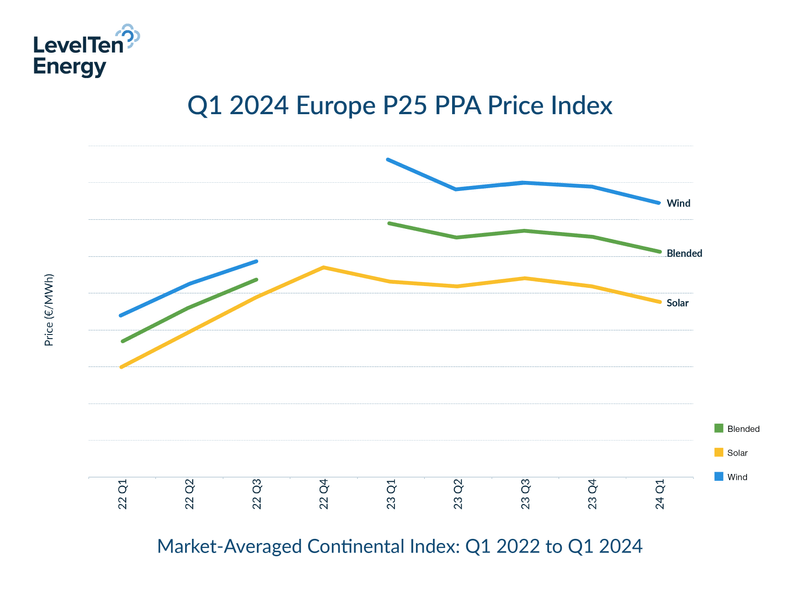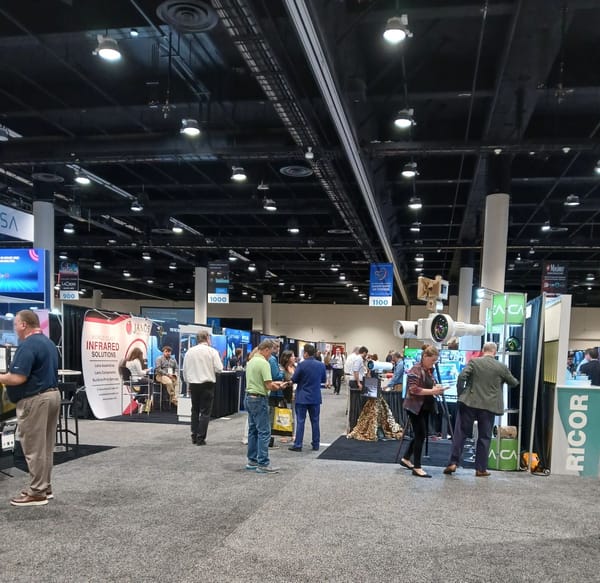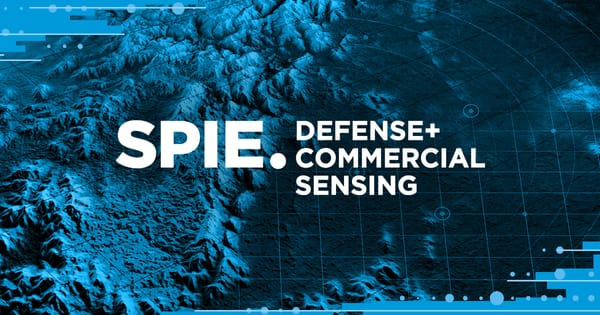Europe’s Renewable PPA Prices Declined 5% in Q1 of 2024, According to LevelTen Energy’s New Report
Power purchase agreement (PPA) prices declined 5% across Europe in the first quarter of 2024, according to a new report from LevelTen Energy.

Power purchase agreement (PPA) prices declined 5% across Europe in the first quarter of 2024, according to a new report from LevelTen Energy, operator of the world’s largest PPA marketplace. Solar P25* PPA prices dropped 5,9% and wind prices dropped 4,3% as the PPA market continued to respond to subdued wholesale electricity prices across Europe — with lower costs in the solar supply chain and a stabilising regulatory landscape contributing as well.
“Following years of turbulence and rising PPA prices, Europe’s energy markets seem to finally be reaching a period of relative stability, with even a light downward trend,” said Plácido Ostos, Director, European Energy Analytics at LevelTen Energy. “But that trend could reverse. Electricity demand will grow, and certain regulatory uncertainty remains. For instance, we’re seeing the potential for increased government oversight on PV component supply. These factors could all impact PPA prices in the near future. The relative stability of the current moment makes now an opportune time for buyers to go to market,” he said.
Solar PPA prices fall in all countries except Romania
“Lower wholesale electricity prices from Europe’s mild winter have put pressure on PPA prices to become more competitive,” said Ostos. Certain markets experienced particularly robust price decreases in Q1, with their P25 prices dropping by 12,7% in Germany and 13,2% in Sweden. Prices in Spain decreased 10,5%, with growing solar price cannibalisation a contributing cause there, too.
“Continued drops in solar module prices due to a flood of China-based PV components also played a role,” he said. “However, the PV supply chain situation has caused Europe’s domestic PV manufacturing industry to call for government intervention — which, if taken, could restrict the supply of cheap components and push solar PPA prices back up,” Ostos said.
A noteworthy exception was Romania, where P25 solar prices went up 8,6%. “Romania’s Q1 price increase is a reversal of last quarter’s trend, which saw an 11% price decrease in Q4. As an emerging PPA market, Romania is more prone to pricing turbulence. Developers and buyers there continue to calibrate what transactable PPA prices in the market look like, which brings the potential for larger quarterly pricing swings,” Ostos said.
Wind prices fall 4,3% as Europe’s wind sector presents reasons for cautious optimism
Mirroring solar trends, Market-Averaged P25 prices for European wind PPAs went down by 4,3% during Q1. “The decline in wind prices was driven by two main factors. On one hand, Spain saw a substantial decline of 8,8% due to limited liquidity for wind projects. On the other hand, some countries that used to make it to our PPA Index did not present enough liquidity this time, thus affecting the overall average,” Ostos explained. “In general, wind development in Europe remains challenging, and supply is constricted,” he said.
“But Europe’s wind sector presents reasons for cautious optimism. Despite the wind PPA market facing reduced supply due to limited land availability and competition from government auctions, there is a noticeable trend of policy initiatives aimed at alleviating points of friction, including streamlining permitting processes and addressing land constraints.The EU’s Wind Power Package also promises broad industry support in the coming years,” Ostos said.
Thanks to greater liquidity, Poland made its first appearance on the Wind P25 PPA Price Index in Q1. “Following years of immensely restrictive wind regulations, it seems that recent policy changes have allowed more wind development in Poland to take root — an encouraging sign for potential offtakers interested in the market,” said Ostos.
Advice to buyers: Understand your options, leverage new innovations, and act fast
“Buyers would be wise to work with expert counsel to understand the market, and leverage a variety of forward curves to understand the full range of scenarios for project performance. Early stakeholder alignment and strong communication with counterparties will increase the likelihood of positive results,” Ostos said.
In 2023, LevelTen and our partners facilitated 42 power purchase agreements, for a record-breaking 98 million megawatt hours of clean electricity. As 2030 sustainability goals loom, more corporate buyers will jump into the PPA pool to make good on their pledges to their customers, investors and employees. This growing demand, plus rising electricity demand from factors like AI usage, electrification, and green hydrogen, will collectively push up the cost of PPAs, meaning corporate buyers who move soon can avoid the impending rush for capacity.
Faced with fast-approaching Scope 2 deadlines and higher competition for PPAs, the market’s savviest buyers are turning to new, faster ways to procure. To answer this need, LevelTen developed LevelTen Energy’s Accelerated Process (LEAP™), which has reduced the timeline of a traditional RFP and PPA negotiation process from the typical 12 months or longer down to about 100 days. Recently, LevelTen and a major tech company announced 1.5 GW procured via LEAP.
“While prices are relatively stable this quarter, they remain high, and companies need options,” Ostos said. “Options like LEAP help buyers navigate current market conditions and make the most of the current moment,” he said.




